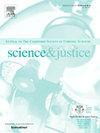Predicting image quality of forensic footwear impressions
IF 1.9
4区 医学
Q2 MEDICINE, LEGAL
引用次数: 0
Abstract
The ability of a footwear examiner to confidently discern features of importance in a forensic examination is directly related to impression quality. As a result, quality directly impacts the strength an examiner can ascribe to any opinion of source attribution. Despite the importance of image quality during both the analysis and comparison phases of an examination, there is limited research on the estimation, variation, and prediction of footwear impression quality. In response, this study aims to develop a methodology for evaluating footwear impression quality by regressing image features against subjective judgments of quality. Using a dataset of more than 450 impressions evaluated by more than 40 participants, estimates of intra- and inter-rater consistency were computed. After identifying reliable raters, matrix completion was performed, thereby permitting data imputation. This was based on an approximate 90:10 split between training and testing data, ultimately resulting in 6,000 quality predictions, which exhibited a mean agreement with ground truth 95%. Each image in the dataset was then reduced to a 10-dimensional feature vector describing image attributes such as complexity, contrast, sharpness, and noise. These features were used to train multiple ordinal and multinomial regression models aimed at predicting image quality. Model comparison resulted in an overall optimal accuracy of approximately 75% when comparing predicted/modeled quality against the ground truth of subjective rater opinions. The resulting semi-automated, reference-free and numerical prediction tool exhibits reasonable success for impression quality prediction when presented with the types of challenging and domain-specific images often encountered in forensic footwear comparisons. The outcomes and challenges associated with this investigation provide a foundation upon which future studies of quality can be modified and built, with the downstream goal of an increased understanding of how quality impacts weight of evidence.
预测法医鞋印的图像质量
鞋类检查员能否在法证检查中自信地辨别重要特征与印模质量直接相关。因此,质量直接影响到检验人员对来源归属的判断力。尽管图像质量在检查的分析和对比阶段都很重要,但有关鞋类印模质量的估计、变化和预测的研究却很有限。为此,本研究旨在通过将图像特征与主观质量判断进行回归,开发一种评估鞋类印象质量的方法。利用由 40 多名参与者评估的 450 多份印象数据集,计算了评分者内部和评分者之间一致性的估计值。在确定了可靠的评分者后,进行了矩阵补全,从而实现了数据估算。这是以训练数据和测试数据大约 90:10 的比例为基础的,最终得出了 6000 个高质量的预测结果,这些预测结果与地面实况的平均一致性为 95%。然后,数据集中的每幅图像都被还原成一个 10 维特征向量,描述图像属性,如复杂度、对比度、清晰度和噪点。这些特征用于训练多个序数和多项式回归模型,以预测图像质量。在将预测/建模质量与主观评分者意见的基本事实进行比较时,模型比较得出的总体最佳准确率约为 75%。当遇到法医鞋类比对中经常遇到的具有挑战性和特定领域的图像类型时,由此产生的半自动化、无参照物和数值预测工具在印象质量预测方面取得了合理的成功。这项调查的成果和挑战为今后的质量研究提供了一个基础,可以在此基础上进行修改和构建,其下游目标是加深对质量如何影响证据权重的理解。
本文章由计算机程序翻译,如有差异,请以英文原文为准。
求助全文
约1分钟内获得全文
求助全文
来源期刊

Science & Justice
医学-病理学
CiteScore
4.20
自引率
15.80%
发文量
98
审稿时长
81 days
期刊介绍:
Science & Justice provides a forum to promote communication and publication of original articles, reviews and correspondence on subjects that spark debates within the Forensic Science Community and the criminal justice sector. The journal provides a medium whereby all aspects of applying science to legal proceedings can be debated and progressed. Science & Justice is published six times a year, and will be of interest primarily to practising forensic scientists and their colleagues in related fields. It is chiefly concerned with the publication of formal scientific papers, in keeping with its international learned status, but will not accept any article describing experimentation on animals which does not meet strict ethical standards.
Promote communication and informed debate within the Forensic Science Community and the criminal justice sector.
To promote the publication of learned and original research findings from all areas of the forensic sciences and by so doing to advance the profession.
To promote the publication of case based material by way of case reviews.
To promote the publication of conference proceedings which are of interest to the forensic science community.
To provide a medium whereby all aspects of applying science to legal proceedings can be debated and progressed.
To appeal to all those with an interest in the forensic sciences.
 求助内容:
求助内容: 应助结果提醒方式:
应助结果提醒方式:


